| 5 January |
• yesterday • tomorrow |
| Memorial of Saint John Neumann, Bishop (United States) |

• Giovanni Nepomuceno Neumann
• Jan Nepomucký Neumann
Son of Philip, who was German and owned a stocking factory, and Agnes Neumann who was Czech. John was a small and quiet boy with four sisters and a brother, and was named after Saint John Nepomucene. An excellent student, John early felt drawn to religious life. Seminarian at Budweis, Bohemia in 1813, he studied astronomy and botany in addition to theological topics. Studied theology at Charles Ferdinand University at Prague in 1833.
When time came for John's ordination, his bishop was sick; the ordination was never re-scheduled as Bohemia had an over-abundance of priests. John decided to go to America to ask for ordination, and to work with emigres. He walked most of the way to France, then took ship for America.
John arrived unannounced in Manhattan in 1836. Bishop John Dubois was happy to see him as there were 36 priests for the 200,000 Catholics in New York and New Jersey. John was ordained on 28 June 1836, and sent to Buffalo. There the parish priest, Father Pax, gave him the choice of the city of Buffalo or of the rural area; John chose the more difficult country area. He stayed in a small town with an unfinished church, and when it was completed, he moved to a town with a log church. There he built himself a small log cabin, rarely lit a fire, slept little, often lived on bread and water, and walked miles to visit farm after remote farm. John's parishioners were from many lands and tongues, but John knew twelve languages, and worked with them all.
He joined the Redemptorists at Pittsburgh, Pennsylvania in 1840, taking his vows at Baltimore, Maryland in 1841, the first Redemptorist to do so in the United States. Home missioner in Maryland, Ohio, Pennsylvania, and Virginia. Rector of Saint Philomena church in Pittsburgh in 1844. Vice-regent and superior of the Redemptorists in America in 1847. Bishop of Philadelphia, Pennsylvania in 1852.
Bishop John built fifty churches and began building a cathedral. He opened almost one hundred schools, and the number of parochial school students in his diocese grew from 500 to 9,000. He wrote newspaper articles, two catechisms, and many works in German. First American man and first American bishop to be canonized.
28 March 1811 at Prachititz, Bohemia (Czech Republic)
• 5 January 1860 of a stroke at 13th and Vine Streets, Philadephia, Pennsylvania
• interred in a glass tomb under the altar at the National Shrine of Saint John Neumann in Philadelphia
19 June 1977 by Pope Paul VI
Since every man of whatever race is endowed with the dignity of a person, he has an inalienable right to an education corresponding to his proper destiny and suited to his native talents, his cultural background, and his ancestral heritage. At the same time, this education should pave the way to brotherly association with other peoples, so that genuine unity and peace on earth may be promoted. For a true education aims at the formation of the human person with respect to the good of those societies of which, as a man, he is a member, and in whose responsibilities, as an adult, he will share. - Saint John Neumann
A man must always be ready, for death comes when and where God wills it. - Saint John Neumann
Merciful Father, You have given me all that I have in this world, even life itself. In all my daily needs, help me to remember the needs of others too. Make me aware of the need to pray to You not just for myself but for the Church, the Pope, for the clergy and for people who suffer any need. Make me as selfless as Saint John Nuemann. Throughout my life, give me the grace to direct my first thoughts to the service of You and of others. Make my prayer - "Your will be done" knowing that in Your mercy and love, Your will for me is my sanctification. I ask this through Jesus Christ, Our Lord. Amen.
https://catholicsaints.info/saint-john-nepomucene-neumann/

Marcellina Mary of the Immaculate Conception
Born to a land-owning Polish family, Marcellina was a pious child with a love of prayer. Though she would have preferred a religious life, she promised her dying father that she would marry and raise a family. Married Karol Darowski in 1849, and sanctified her marriage "by living only in God and for God." Karol died less than 3 years later, leaving her a widowed mother of two. Her son died a year later, and she wrote, "The way of the world was not chosen for me by God's will; the way of the convent was, indeed, my destiny."
She traveled to Rome, Italy in 1854 for reasons of health, and there met Father Hieronim Kajsiewicz, a Resurrectionist who became her spiritual director. Through him she met Josephine Karska, who wished to found a religious community dedicated to the overall formation of women. The result was the Congregation of the Sisters of the Immaculate Conception of the Blessed Virgin Mary.
Josephine suffered with typhus for years, and died in 1860, leaving Marcelina as Superior of the new religious family, which numbered no more than four. In 1863 Marcelina moved them to her homeland. At Jazlowiec, Archdiocese of Lviv, Ukraine, she opened her first school for girls. It soon became an important spiritual and cultural center.
Marcelina approached women's education believing that on it depends the re-birth of the family, the foundation of a morally healthy society. She stressed the following to sisters and students: the primacy of God over everything, truth, mutual trust, and unselfishness. She offered help to the poor, working for tuition-free elementary schools at every convent. During her 50 years as Superior she opened seven convents with formation institutes and schools for children.
28 January 1827 at Szulaki, Poland (now in Ukraine) as Marcelina Kotowicz
5 January 1911 at Jazlowiec, Poland (now in Ukraine) of natural causes
6 October 1996 by Pope John Paul II
I don't look at the results of our work. They don't belong to us. If they exist, they belong to God for the good of our beloved country, which is torn apart. - Blessed Marcelina
"He who abides in me, and I in him, he it is that bears much fruit." (John 15:5) Today the Church rejoices that Blessed Marcelina Darowska, co-foundress of the Congregation of Sisters of the Immaculate Conception of the Blessed Virgin Mary, has been raised to the honours of the altar. Blessed Marcelina's whole life was a ceaseless "abiding in God" through prayer and faithful imitation of Jesus Christ, who "loved man to the very end." (cf. John 13:1) "To extend the kingdom of God in human souls and bring it into the world" - this was the programme for her apostolic activity, born in the silence of a heart immersed in prayer. She wanted to do everything so that truth love and goodness would triumph in human life and transform the face of her beloved nation. Together with her sisters, she generously laboured in the exhausting task of building the kingdom of Christ, paying particular attention to the religious formation of the young generation, especially girls, to the growth of catechesis and to educational work. She assigned a particular role in life to the Christian woman as "wife, mother and citizen of her country". With great zeal she fostered the growth of the kingdom of God in the family, since only a healthy and holy family, "based on God", as she said, can be the foundation of a new society. The new blessed is an example of an apostolic faith that creates new ways for the Church to be present in the world and forms a more just and human society which "abides and bears fruit" in Christ. - Pope John Paul II, from the proclamation of the beatification of Blessed Marcelina, 6 October 1996
https://catholicsaints.info/blessed-marcelina-darowska/
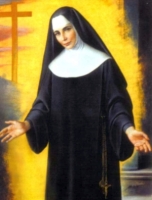
Daughter of a notary, and the oldest of eleven children. It was a pious family - three of her sisters became nuns, one brother a priest. Maria joined the Daughters of Our Lady of Refuge (Brignolines) in Genoa, Italy on 7 May 1829, making her final vows in 1831. Seamstress and embroiderer for many years.
When her eyesight began to fail, she was made portress and gatekeeper of her convent, keeping the world out, and being the face of the convent to those outside. Believing in the good of work, and needing diplomatic skills in her position, Sister Maria developed a deep devotion to Saint Joseph, constantly asking for his prayers, protection and guidance. She distributed small medals and images of Joseph, and could heal by placing the image over the affected area, and praying. Owning nothing herself, she still managed to care for the poor. Maria worked selflessly with the sick during cholera epidemics of 1835 and 1854.
Maria's largesse caused some troubles within her community. The sheer number of people who showed up each day was considered by some of her sisters to be a disruption to their religious lives, and for a while Sister Maria was relieved of her position. She believed it was because she had sinned in some way, and spent most of her time in prayer. Eventually, however, her superiors re-evaluated their decision, and returned Maria to her place at the door.
All her life Maria would un-self-consciously speak to Jesus or the Father as she went about her duties, and toward the end of her life she began to hear answers and see visions of coming home to God.
1 November 1807 at Voltaggio, Italy
• 6 January 1890 at Genoa, Italy of natural causes
• interred in her house's chapel
4 October 1981 by Pope John Paul II
[A woman came to the convent to ask] for prayers for her husband who had gone blind. Sister [Maria] advised her to pray to Saint Joseph, then she went to her room and turned the picture of the saint towards the wall, saying, "Try yourself to see what it means to be in the dark." The next day the woman returned and said that suddenly her husband's sight had returned. Sister Maria quickly ran to her room and turned the picture back around, simply saying, "Thank you, Saint Joseph!" Her behavior, which might seem a bit surprising, shows her complete childlike freedom with respect to the great saint. - Dom Antoine Marie, OSB, discussing Blessed Maria
From her youth Maria Repetto learned and lived a great truth, which she has trasmitted also to us: Jesus must be contemplated, loved and served in the poor, at all moments of our life.. To serve Christ's poor was a program of her Institute, a program which she carried out in fifty years of religious life, serving Jesus above all, growing in the perfection of love. - Pope John Paul II in his beatification homily for Blessed Maria
https://catholicsaints.info/blessed-maria-repetto/
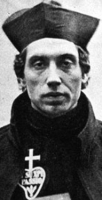
• Charles Houban
• Charles Houben
• Charles of Mount Argus Houben
• Charles of Saint Andrew
• Joannes Andreas Houben
• Karel Houben
• Karel of Mount Argus
• Karel of Saint Andrew
• Karel van Sint Andries Houben
• Karl Houben
• Saint of Mount Argus
Fourth of eleven children born to Peter Joseph and Elizabeth Jane Houban. Made his first Communion at age 13. Studied at Sittard; he was a slow learner, but a very dedicated student. Enlisted in the military in 1840, and served five years. After the military, Joannes worked briefly in his uncle's mill. He joined the Passionists at Ere, Belgium on 5 November 1845, taking the name Charles of Saint Andrew. Ordained on 21 December 1850. Assigned to England in 1852 where he often worked with Irish immigrants fleeing the Potato Famine. Transferred on 6 July 1857 to a retreat house in an area near Dublin, Ireland called Mount Argus. Except for a brief trip to England in 1866, he spent the rest of his remaining 36 years there. He invigorated the area faithful, and was a noted healer. When word of his holiness spread, carriages came to fetch him to the bed side of the sick, and he daily received mounds of mail with prayer requests. The whole city, including non-Catholics, recognized the holiness of Father Charles, and mourned his passing.
11 December 1821 in Munstergeleen, Limburg, Netherlands as Joannes Andreas Houben
• 5 January 1893 at Mount Argus, Ireland from an infected leg wound received in a carriage accident
• buried at Mount Argus, Dublin, Ireland
3 June 2007 by Pope Benedict XVI at Saint Peter's Basilica, Rome, Italy
Most Holy Virgin Mary Oh, my Mother! How sweet it is to come to thy feet, imploring thy perpetual help! If earthly mothers cease not to remember their children, how canst thou, the most loving of all mothers, forget me? Grant then, to me, I implore thee, thy perpetual help in all my necessities, in every sorrow, and especially in all my temptations. As we are all thy children, I ask for thy unceasing help for all who are now suffering. Help the weak, cure the sick, convert sinners, and console all earthly mothers who are now weeping over their children. Open the gates of heaven to those we loved upon earth and who are now suffering in purgatory. Obtain for us, dear Mother,that having earnestly invoked thee on earth, we may see thee, love thee, and eternally thank thee hereafter in heaven. Amen. Mother of Holy Hope, pray for us. - prayer of Saint Charles to Our Lady, Mother of Holy Hope
https://catholicsaints.info/saint-charles-of-mount-argus/
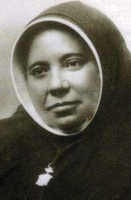
Youngest of six children. By the age of eight, both her parents and four of her siblings had died. A child homemaker for her older brother, Genovena grew up a quiet child, accustomed to solitude. She took an interest in spiritual reading around age ten, and early understood that the purpose of all life is to follow God. When she was 13, her left leg became gangrenous and had to be amputated; there was no anesthesia for the operation, it never properly healed, and she was on crutches the rest of her life.
From 1885 to 1894 she lived at the Mercy Home run by the Carmelites of Charity, healing, learning to sew, and deepening her spiritual life. She wanted to join these sisters, but her health was not good enough. In 1894 she moved in with two other lay women who supported themselves and each other, living a poor but prayerful life. The desire to help poor women grew in Genoveva, and in 1911 Canon Barbarrós suggested she start a religious community for just such a mission. Shea established the first community of the Congregation of the Sacred Heart of Jesus and the Holy Angels (Angélicas) in Valencia, Spain; they would receive papal approval in 1953. It immediately attracted many women, both those needing help, and those wanting to help, and other communities were formed around Spain. Genoveva spent the rest of her life working for these communities, overcoming her physical and health problems, and even tougher, her own desire for quiet solitude.
3 January 1870 in Almenara, Castile, Spain
5 January 1956 in Zaragoza, Spain of natural causes
4 May 2003 by Pope John Paul II at Plaza de Colón, Madrid, Spain
I loved freedom of heart very much, and worked and am working to achieve it fully. It does the soul so much good that every effort is nothing compared with this free condition of the heart. - Saint Genoveva
Even if I must suffer greatly, thanks be to God's mercy, I will not lack courage. - Saint Genoveva
Saint Genoveva Torres was an instrument of God's tender love for lonely people in need of love, comfort and physical and spiritual care. The characteristic note that fuelled her spirituality was adoration of the Eucharist for the expiation of sins, which formed the basis of an apostolate full of humility and simplicity, of self-denial and charity. - Pope John Paul II in his homily at the canonization of Saint Genoveva
https://catholicsaints.info/saint-genoveva-torres-morales/
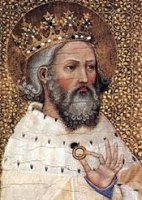
Born a prince, the son of King Ethelred II and Queen Emma; half-brother to King Edmund Ironside and King Hardicanute. When his father was unseated by Danish invasion. Edward and his brother were sent to Denmark to be quietly killed, but the officer in charge took pity on the boys, and sent them to Sweden, and from there they went to the King of Hungary to be raised and educated. Edward's interests were in things religious. When grown, the brothers moved to Normandy and waited their chance to return to England.
In 1035 Edward and Alfred tried to regain the crown of England, but they were turned back, Alfred was killed, and Edward returned to Normandy. He returned to England again in 1042, and was chosen king by acclamation, ascending the throne on 3 April. Edward gained a reputation as just and worthy of the kingship, and the people of England supported him.
During his reign Edward repulsed invasion, helped restore the King of Scotland to his throne, remitted unjust taxes, and was noted for his generosity to the poor and strangers, and for his piety and love of God. He married to satisfy his people, but he and the queen remained chaste. Reported to have the power to heal by touch. Built churches, including Westminster Abbey.
1003 at Islip, Oxford, England
• 5 January 1066 of natural causes • interred at the Abbey of Saint Thomas Becket • body incorrupt
1161 by Pope Alexander III
• difficult marriages
• English royal family
• kings
• separated spouses
• Sestriere, Italy
• carrying a sick man on his shoulders
• curing a leper
• elderly king offering a ring or coin to Saint John who is disguised as a beggar
https://catholicsaints.info/saint-edward-the-confessor/

• Gerlac von Houthem
• Gerlac of Maastricht
• Gerlach, Gerlache, Gerlacus, Gerlachus, Gerlak
Born the nobility, he served as a soldier in the imperial German army. Led a wild and licentious life, part as a highwayman, until the death of his wife, after which he experienced a conversion. Did penance the rest of his life, first by caring for the sick in Jerusalem for seven years, then giving away his property, living as a hermit in a hollow tree near his own estate. Each week he travelled to Maastricht to venerate the relics of Saint Gervase, to Aachen, Germany to venerate Our Lady. Much slandered because of his early life and his austerities. Late in life he developed a dispute with some local monks who wanted him to join their monastery. Friend of, and correspondent with Saint Hildegard of Bingen. Had a vision of Saint Gervase on 5 January 1170.
c.1100 at Valkenburg, Netherlands
1172 - 1177 at Houthem, the Netherlands of natural causes
• against cattle disease
• against plague
• domestic animals
• hermit accompanied by an donkey
• hermit wearing a Norbertine habit
• hermit with a thorn in his foot
• man living in a hollow tree
• man surrounded by farmers and cattle
• man riding a donkey away from a tournament, showing how he turned his back on the chivalrous life
https://catholicsaints.info/saint-gerlac-of-valkenburg/
Priest at Carthage. Bishop of Carthage in 453, the first bishop of the city in 14 years. Initially well-loved by Christians, pagans, and heretics.
During his bishopric he sold everything he could, including the diocesan gold and silver plate, works of art, and equipage of the Mass in order to ransom and house Christians captured and taken to north Africa as slaves by the Vandal king Genseric following the sack of Rome, Italy. He made special attempts to buy and keep together whole families, turned his largest churches, Basilica Fausti and Basilica Novarum, into dormitories and hospitals for the refugees, and when his duties gave him the time, he worked in the sick wards.
Arians in the region eventually turned on him, and he survived several assassination attempts to die in his own bed, exhausted from his work. The Vandals refused to allow another bishop to occupy the see for another 23 years.
• 457 in Carthage (modern Tunis, Tunisia) of natural causes
• buried secretly to avoid destruction of his grave by relic seekers
https://catholicsaints.info/saint-deogratias-of-carthage/

Sincletica
Wealthy Alexandrian lady who abandoned her riches and lived till age 84 as a hermitess in a tomb. She suffered in her youth with temptations and spiritual desolation; she suffered in her maturity by cancer and consumption.
• against bodily ills or sickness
• against loss of parents
• against temptations
• sick people
• single laywomen
Adorned with wisdom and grace, O blessed Syncletica, Thou wast unshaken by hostile attacks. Ever pray for those who celebrate thy memory. - troparion of Saint Syncletica
Illustrious with rays of heavenly virtue, O Godbearing Syncletica thou didst blunt the goads of the ancient enemy, and bring a company of virgins to the bridal chamber. Together with them pray for us that we may find mercy. - kontakion of Saint Syncletica
https://catholicsaints.info/saint-syncletica/

Gaudenty, Radim, Radzim Slavnik, Radim Gaudentius
Born into the Bohemia nobility; younger brother of Saint Adalbert of Prague. Following the massacre of his family by a political rival, Radzim became a monk at the Benedictine abbey of Saint Alessio, Aventine, Rome, Italy. Missionary to Prussia with Adalbert, he escaped the anti-Christian massacre in which Adalbert died. Archbishop of Gniezno in 1000, appointed by Otto III; he led his flock through end-of-the-world rumours that accompanied the new millenium.
c.960 at Castle Libice near Pardubice, Bohemia (in modern Czech Republic as Radzim
• c.1004 in Gniezno, Bohemia (in modern Poland) of natural causes
• relics transferred to the Saint Veit Cathedral in Prague, Bohemia (in modern Czech Republic) in 1039
https://catholicsaints.info/saint-gaudentius-of-gniezno/
• Romanus the Neomartyr
• Romanos...
A pius and illiterate man, following a pilgrimage to the Holy Lands, Romanus sought spiritual direction at the monastery of Saint-Sabas on Mount Athos. He then returned to Thessalonica where he pubicly confessed his Christianity in front of Muslim Turks. Romanus was condemned to serve as a galley slave for this crime, but was later ransomed, regained his freedom, and spent more time in spiritual retreat on Mount Athos, this time at the Kavsokalyvia monastery. Again feeling a call to witness to Muslims, he travelled to Constantinople where he proclaimed his faith to the Muslim Turks. This time his crime led to torture and execution. Martyr. He is especially venerated in the Eastern churches.
17th century Crete or central Greece
thrown into a dry well to starve for 40 days, and then beheaded in 1694 in Constantinople
https://catholicsaints.info/blessed-romanus-of-athos/
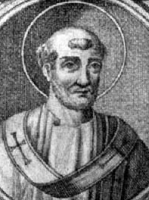
Telesforo
Greek, probably from Calabria. Pope. Celebrated Easter on Sunday but maintained fellowship with communities that did not. Started the tradition of Christmas Midnight Mass, and decided that the Gloria should be sung. Some legends say he was a hermit before his election, and that he instituted the tradition of Lent, but these are doubtful. Martyred, possibly due to conversions caused by his preaching.
128 to 129
martyred 138 to 139
• pope with a chalice over which three Hosts hover (may refer to the celebration of Christmas with three Masses said to represent the temporal, spiritual, and eternal birth of Christ)
• pope with a chalice with a nearby club (possibly an indication of his martyrdom)
https://catholicsaints.info/pope-saint-telesphorus/
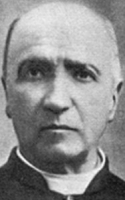
Peter Bonilli
Priest in the diocese of Spoleto, Italy, ordained in 1863. Parish priest in Cannaiola, Trevi, Italy for 34 years. Founded the Suore della Sacra Famiglia (Sisters of the Holy Family) on 13 May 1888 for the care and education of orphans, the deaf, the blind, the homeless and especially needy girls. Canon of the cathedral of Spoleto, Italy in 1898.
15 March 1841 in San Lorendo di Trevi, Perugia, Italy
• 5 January 1935 in Spoleto, Perugia, Italy of natural causes
• relics enshrined in the church of Michael the Archangel in Cannaiola di Trevi, Italy where he had served as parish priest for many years
24 April 1988 by Pope John Paul II
https://catholicsaints.info/blessed-pietro-bonilli/

• Convoyon of Brittany
• Conwoion, Convoion, Convoio, Konvoion, Konvoyon, Konwoion
Archdeacon of Vannes, France. Hermit. Benedictine monk at Glanfeuil, France. Founded Saint Savior monastery near Redon, France in 831, and served as its first abbot. Spiritual teacher of Saint Fidweten. Invading Norseman attacked the monastery and drove him into exile where he spent his later years.
in 788 Saint-Malo, Brittany (in modern France
• 5 January 868 at Saint-Maixent-de-Plélan monastery, Plélan, France of natural causes
• re-interred at Redon Abbey
• relics destroyed during the French Revolution
3 May 1866 by Pope Pius IX (cultus confirmed)
https://catholicsaints.info/saint-convoyon-of-redon/
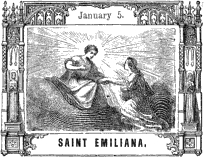
Aemiliana, Emilian, Emilienne
Daughter of the senator Gordian and Saint Silvia of Rome. Sister of Saint Trasilla. Paternal aunt of Pope Saint Gregory the Great. Niece of Pope Saint Felix III. Spent so much time kneeling in prayer that her knees and elbows were locked arthritically in the position. She and her sister lived as hermits in their father's house until Thrasilla's death. Visionary who received a visit from her recently deceased sister inviting her to depart this vale of tears; Emiliana died a few days later.
Roman citizen
relics at the Oratory of Saint Andrew on the Celian Hill, Rome, Italy
single laywomen
https://catholicsaints.info/saint-emiliana-of-rome-24-december/
Three monks and their abbot who lived at the San Sabinus monastery in Piacenza, Italy and were noted for their piet.
https://catholicsaints.info/saint-ambrosius-of-piacenza/, https://catholicsaints.info/saint-lucas-of-piacenza/, https://catholicsaints.info/saint-privatus-of-piacenza/, https://catholicsaints.info/saint-victorinus-of-piacenza/
24 July (finding of relics)
Brother of Saint Eusebia of Bergamo; grandson of Saint Domnio of Bergamo. Imprisonsed for his faith during the persecutions of Maximian. He was tortured and eventually died by having hot coals dumped on his head; his only response was to praise God. Martyr.
• 307 outside the city of Bergamo, Italy
• buried next to his grandfather Domnio
• the church of Saint Andrew was later built over the site of the graves
https://catholicsaints.info/saint-domno-of-bergamo/
Daughter of Saint Euprexia of Mineo. She became paralyzed under unknown circumstances.
early 4th century in Mineo, Caltagirone, Sicily, Italy
https://catholicsaints.info/saint-theognia-of-mineo/
Fosterias, Phosterio, Phosterius
Sixth-century mountain hermit noted for going into the community to defend orthodox Christianity against the heresies of the day. Later legends added that he lived on a high rock, ate nothing but bread brought to him by an angel, that the angel brought so much that he distributed loaves to the poor who would gather around him to be healed by his prayers, and that so many people came for his blessing and bread that he had to built and led an abbey to accomodate them.
https://catholicsaints.info/saint-phosterios/
Married lay woman. Mother of Saint Theognia of Mineo. Widow.
The relics of Saint Agrappina were brought from Rome, Italy to a cave near the home of Saint Euprexia where exposure to them cured Saint Theognia of her paralysis. In gratitude, Euprexia built a chapel in her home for the relics and had them enshrined there. By the year 312, the church of Saint Agrippina was built on the site of the house.
early 4th century in Mineo, Caltagirone, Sicily, Italy
https://catholicsaints.info/saint-euprexia-of-mineo/
Cail, Ceara, Cera, Cere, Chera, Chier, Ciar Asgadh, Ciar, Ciara, Cior, Cyra, Kaila, Keara, Kera, Kere, Kère, Kiara, Kyaer, Kyear
Nun. Spiritual student of Saint Fintan Minnu. Abbess of a monastery at Tehelly, Ireland. Founder and abbess of a house near Nenagh, County Tipperary. Ireland. Kilkeary, Ireland is named in her honour.
in Tipperary, Ireland
679 of natural causes
https://catholicsaints.info/saint-cera-of-kilkeary/
2 January as one of the Martyrs of Anjou
Priest of the diocese of Angers, France. Martyred in the persecutions of the French Revolution.
26 April 1728 in Savennières, Maine-et-Loire, France
5 January 1794 in Angers, Maine-et-Loire, France
19 February 1984 by Pope John Paul II at Rome, Italy
https://catholicsaints.info/blessed-francois-peltier/
2 January as one of the Martyrs of Anjou
Priest of the diocese of Angers, France. Martyred in the persecutions of the French Revolution.
11 May 1766 in La Trinité-d'Angers, Maine-et-Loire, France
5 January 1794 in Angers, Maine-et-Loire, France
19 February 1984 by Pope John Paul II at Rome, Italy
https://catholicsaints.info/blessed-pierre-tessier/
2 January as one of the Martyrs of Anjou
Priest of the diocese of Angers, France. Martyred in the persecutions of the French Revolution.
3 April 1760 in Rochefort-sur-Loire, Maine-et-Loire, France
5 January 1794 in Angers, Maine-et-Loire, France
19 February 1984 by Pope John Paul II at Rome, Italy
https://catholicsaints.info/blessed-jacques-ledoyen/
Father Robert
Member of the Benedictines (Subiaco Congregation). Priest. Martyred in the Spanish Civil War.
14 April 1895 in Coll de Nargó, Lleida, Spain
5 January 1937 in Barcelona, Spain
• 13 October 2013 by Pope Francis
• beatification celebrated in Tarragona, Spain
https://catholicsaints.info/blessed-joan-grau-bullich/
Dorotheus
Daughter of an emperor of Rome. Feeling drawn to religious life, she dressed as a man, moved to the desert, called herself Dorotheus, and lived as a hermit. Spiritual student of Saint Macarius of Egypt. Her sex was discovered only at her death. It's possible this is a case of pious fiction being mistaken for history.
https://catholicsaints.info/saint-apollinaris-syncletica/
Dorotheus of Khiliokomos
Monk at Samsun, Turkey on the Black Sea. Following the command of a mysterious stranger, he founded a monastery at Khiliokomoas, and served as its first abbot. Long-suffering spiritual teacher of Saint Dositheus of Gaza.
11th century in Trebizond (modern Trabzon, Turkey)
https://catholicsaints.info/saint-dorotheus-the-younger/
Ruggero, Ruggiero
Franciscan, receiving the habit from Saint Francis himself in 1236. Spiritual director of Blessed Philippa Mareria's community of Poor Clares at Rieti, Italy.
5 January 1237 at Todi, Italy of natural causes
24 April 1751 by Pope Benedict XIV (cultus confirmed)
https://catholicsaints.info/blessed-roger-of-todi/
Placed into the care of the local Camaldolese nuns while she was very young, she remained with the order, student and nun, for the rest of her life. Best known for her work as a peacemaker between the Italian cities of Florence and Pisa.
1318 in Tuscany, Italy
1368 of natural causes
https://catholicsaints.info/blessed-paula-of-tuscany/
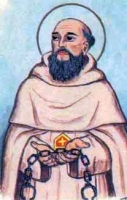
Mercedarian friar at the convent of Santa Maria di Montebianco in Tarragona, Spain. Sent to Tunis in north Africa where he rescued 130 Christians enslaved by Muslims.
Tarragona, Spain of natural causes
https://catholicsaints.info/blessed-dionisio-ammalio/
Grew up a shepherd on the island of Crete. Lived as a prayerful beggar in Jerusalem for 12 years. Became a monk in Rome, Italy. Friend of Saint Michael the Confessor. He accompaned Saint Michael to Constantinople where he spent his remaining days as a monk.
820 in Constantinople in 820
https://catholicsaints.info/saint-gregory-of-crete/
• Talida of Thebes
• Talida of Thebais
• Amata, Amma Talida, Diamant
Nun. Abbess. Head of a group of convents in Egypt. Lived over 80 years as a nun.
4th century in Egypt of natural causes
https://catholicsaints.info/saint-talida-of-antinoe/
28 March (discovery of relics)
Sixth century bishop of Brescia, Italy.
• c.594 of natural causes
• relics interred in the parish church of Saint Zeno in Brescia, Italy
https://catholicsaints.info/saint-rusticianus-of-brescia/
Astolfo, Haistulf, Uistulfus
Monk in Wissemburg, Germany. Early 9th century bishop of Mainz, Germany. Ordained Blessed Rabanus Maurus as a priest.
28 January 826 in Mainz, Germany of natural causes
https://catholicsaints.info/saint-astolfus-of-mainz/
Honulph, Honulpho
31 August (discovery of relics)
Father of Saint Honobertus of Sens. 38th bishop of Sens, France c.755.
c.761 of natural causes
https://catholicsaints.info/saint-honulphus-of-sens/
Monk and abbot of the monastery of Saint Catherine on the Sinai peninsula in the desert of Egypt for 15 years. Saint John Klimakos.
latter 6th-century at monastery of Saint Catherine, Egypt of natural causes
https://catholicsaints.info/saint-menas-of-sinai/
Benedictine Cistercian monk. Prior at Casamari, Veroli, Italy. Papal legate to Germany for Pope Innocent III and Pope Honorius III. Bishop.
1216 of natural causes
https://catholicsaints.info/blessed-alacrinus-of-casamari/
Aunobertus
Son of Saint Honulphus of Sens. 37th bishop of Sens, France c.738.
c.755 of natural causes
https://catholicsaints.info/saint-honobertus-of-sens/
Martyr.
c.300 in Sardinia, Italy
https://catholicsaints.info/saint-theodore-of-cagliari/
Martyr.
trampled to death
https://catholicsaints.info/saint-theoidus/
Nun noted for her ascetic life.
https://catholicsaints.info/saint-tatiana/
A group of Christians martyred together in Africa, date unknown, exact location unknown. We know nothing more than their names - Acutus, Anastasia, Candidus, Coelifloria, Felix, Honorius, Januaria, Jucundus, Lucianus, Marcus, Petrus, Secundus, Severus and Telesphorus.
https://catholicsaints.info/martyrs-of-africa-5-january/
A group of Christians martyred for their faith, but about whom no details have survived.
drowned near Sais, Egypt
https://catholicsaints.info/martyrs-of-sais/
Martyrs of Thebaid
There were many martyrs who suffered in the persecutions of Diocletian in the Thebaid region. Though we know these atrocities occurred, to the point that witnesses claim the torturers and executioners were exhausted by the work, we do not know the names of the saints, and we honour them as a group.
beheaded and burned alive in 303 in Upper Egypt
https://catholicsaints.info/martyrs-of-upper-egypt/
CatholicSaints.Info Portable Edition